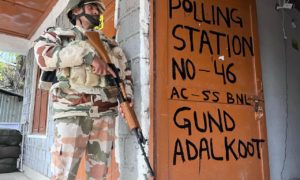Srinagar: Days after India claimed to have gained control of several key heights in Ladakh amid the India-China border tensions, there has been a major force build-up of Chinese tanks and infantry forces in the south Pangong region.
According to reports, Chinese artillery would be located in ‘depth’ positions, more than twenty kilometres away from the Line of Actual Control (LAC).
Quoting sources, a report published by a Delhi based news organisation NDTV, said that the presence of additional tank forces has been detected not too far from Chinese positions in Moldo in South Pangong.
However, Chinese army, according to reports, continues to dominate in various areas. The movement is also being well sighted by the Indian Army ”as it dominates the heights from Thakung to beyond Mukpari.”
This reportedly includes control of both shoulders of the crucial Spanggur Gap, a high-altitude pass that spans more than two kilometres in width through which tanks can operate.
Meanwhile, the Indian army has also deployed additional forces to shore up the heights that it holds along the disputed Line of Actual Control in the region.
As Indian forces are on heights, the report said it can engage Chinese armour and troop formations with anti-tank guided missiles, rockets and other weapons.
India also operates missile-armed T-90 heavy main battle tanks in addition to upgraded T-72M1 tanks in high-altitude areas in Eastern Ladakh.
However, the report mentions that even after the area is dominated by Indian forces, Chinese Army continue to hold positions on Black-Top and Helmet, two features on the Chinese side of the LAC.
Quoting sources NDTV report said that both positions are within the range of Indian armed forces personnel near-by heights and hold ground at the base of these features. In other words, any lengthy maintenance and replenishment of these Chinese posts would be challenging.
“There has been heavy air activity as well along the Line of Actual Control with the Chinese Air Force stepping up its fighter deployment from both the Ngari-Gunsa and Hotan air bases in Tibet. The bulk of the Chinese fighter-flying has been done by home-built versions of the Sukhoi 30 fighter which also happens to be the mainstay of the Indian Air Force,” the report quoted sources as having said.
Pertinently, the army Chief General Manoj Mukund Naravane, who was o two day visit to Ladakh to review the ground situation has said that situation along the LAC is “slightly tense.” He sad: “we have undertaken some precautionary deployments for our own safety and security”.
“In view of the situation, we have undertaken some precautionary deployments for our own safety and security. These deployments, we undertook along the LAC,” the report quoted army chief as saying.
Stating that it is unclear if the Chinese are performing round-the-clock fighter sweeps in the region, both the IAF and the Chinese Air Force have deployed electronic warning and support aircraft in the region.
According to the report, the IAF, which is heavily deployed at multiple air bases across North India would respond to Chinese air activity by flying its own combat-sorties across the Line of Actual Control.
Free Press Kashmir is now on Telegram. Click here to Join.








